| View previous topic :: View next topic |
| Author |
Message |
larsr


Joined: 25 Jun 2009
Posts: 272
Location: Helsinki, Finland
|
 Posted: Fri Dec 04, 2009 4:20 pm Post subject: Posted: Fri Dec 04, 2009 4:20 pm Post subject: |
 |
|
larsr wrote:
| Orio wrote: |
But today, after autofocus and digital, a lot of the older Nikon lenses are available for the same used price of Flektogons. Sometimes even for less. So the thing makes a lot less sense to me. Because it is obvious, that any Nikkor superwide (just an example, the 3.5/20, which I used to own) will perform better, on a Nikon camera, then a Flektogon 20 with optical adapter. And the cost of the two used lenses is the same, if not even more favorable for the Nikkor today.
So where is the point in using optical adapters, at all?
I have read a lot of talk on the subject in the last couple of years, but I still have to read a good answer to this question. |
While it may be correct to compare a Nikkor to a Flektogon, I don't find it correct to compare some cheap $20 Helios lens to more expensive Nikkor lenses. For what little you pay, you can get very decent results, and the more you pay, usually the better quality you get - in technical terms.
A 28/2.8 AIS Nikkor is superior compared to a 28/2.8 Chinon. I paid 240€ for the Nikkor, 20€ for the Chinon and 10€ for the optical adapter. While the quality may arguably be severely different, I find cheap manual lenses interesting, which is why I buy them - and use them with an adapter.
Now, as Vilhelm said - while you and I may see a total difference in IQ, we need to remember that even if we take photos for our own pleasure, the general public who views them, will not notice. People like my mom who looks at pictures I have taken does not pay attention to corner softness or aberration, she pays attention to what's in the photo, what or who the photo portrays, does the photo tell a story and oh, look, how vibrant colors!
If I can buy gear for $30 and take photos that my friends and people who like art but are not anal about it, will appreciate, I think my purchases are justified.
People who develop their film into photos store them into albums. The quality of these photos will inevitably degrade along the years. The photos taken 30 years ago bring back vivid memories even if they are not sharp all around. They're photos, subject for viewing, not technical analysis.
Even famous hallmark photographers took pictures which weren't sharp from edge to edge.
I'm sorry, but I just don't see the point.
_________________
Lars
Bodies:
DSLR: Nikon D200
SLR: Nikon FA, Pentax Spotmatic SPII, Zeiss Ikon Icarex 35TM
35mm: Voigtl�nder Vitoret
Nikkor MF
24/2.8K AI'd, 28/2.8 AIS, 35/2 AIS, 50/1.4 AIS, 50/1.8 AIS, 50/2 AI, 55/2.8 Micro, 35-70/3.5 AIS, 85/1.8K AI'd, 100/2.8 Series E, 105/2.5 AI, 105/2.5 AIS, 135/3.5 AI, Nikkor 180/2.8 ED AIS, 200/4-Q AI'd, 300/4.5-H AI'd
M42
Misc: Vivitar 28/2.5, Chinon 28/2.8, Cosina Auto Cosinon 50/1.8, Revue Auto Revuenon 50/1.8, Mamiya 50/2, Auto Flex 55/1.7, Cosina Cosinon 135/2.8 MC, Vivitar 135/2.8, Petri 200/3.5 CC Auto
Zeiss: Carl Zeiss (Ikon) Tessar 50/2.8, CZJ Tessar 50/2.8, CZJ Pancolar Electric 50/1.8 MC, CZJ Biotar 58/2 T, CZJ Sonnar MC S 135/3.5
Asahi-Pentax: SMC-Takumar 55/1.8, Super-Takumar 105/2.8, SMC-Takumar 135/3.5
USSR: Mir-1 37/2.8 (1958 GP), Helios 44-2 58/2
Pentacon/Meyer: Pentacon 29/2.8 MC, Pentacon 50/1.8 MC Electric, Meyer G�rlitz Oreston 50/1.8, Meyer G�rlitz Orestor 135/2.8, Pentacon 200/4
Nikkor AF
50/1.8 D, 60/2.8 Micro, 55-200/4-5.6 G VR, 70-300/4-5.6 ED, 18-70/3.5-4.5 G
Wantlist
Nikkor 105/1.8, Nikkor 135/2
|
|
| Back to top |
|
 |
sichko


Joined: 20 Jun 2008
Posts: 2475
Location: South West UK
|
 Posted: Fri Dec 04, 2009 8:03 pm Post subject: Posted: Fri Dec 04, 2009 8:03 pm Post subject: |
 |
|
sichko wrote:
| Orio wrote: |
I don't think that UV filters that are properly made, are supposed to deviate the direction of the light rays... |
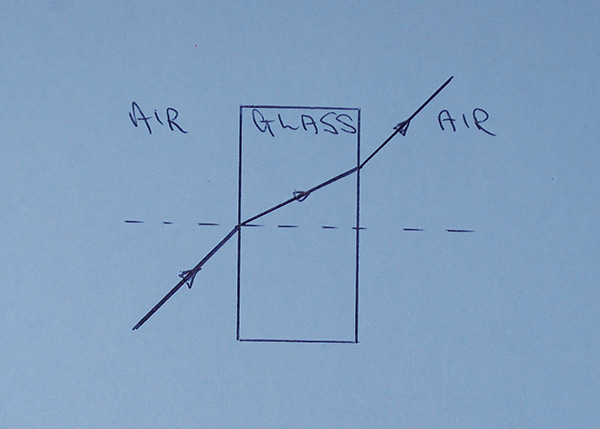
Yes they are. It's called refraction. The incident light ray, in air on the left, bends towards the normal (dashed line) at the air-glass boundary because the glass is denser than the air. At the glass-air boundary the ray bends in the opposite direction as it moves into a less dense medium - the air on the right. If the glass (filter) has two perfectly parallel surfaces the ray leaving the filter, on the right, will be parallel to the ray entering the filter, on the left. However the two rays are not coincident. The filter causes a deviation.
| Quote: |
...which is what optical adapters obviously do, since their purpose is to refocus them.
Of course I am no technician and don't pretend to be one, but simple logic tells me that there is a difference. |
The (ideal) filter has two parallel flat faces. The adapter element has (typically) curved surfaces. Refraction occurs in both. The adapter may serve to refocus the light rays. However this happens because the adapter is curved AND because of refraction. The phenomenon of refraction is general for any interface between two media with different refractive indices.
| Quote: |
| On a more general level, I always thought that optical adapters do not have a real justification to exist today, .... |
Yes they do - they allow you to take pictures with cheap lenses.
| Quote: |
| .....when most lenses are available used for little or reasonable money. |
It depends on who you are and what you mean by little or reasonable. For some people a Helios 44x might be affordable when a Nikkor 50mm f/1.8 might not be.
_________________
John |
|
| Back to top |
|
 |
Esox lucius


Joined: 26 Aug 2008
Posts: 2441
Location: Helsinki, Finland
Expire: 2011-11-18
|
 Posted: Fri Dec 04, 2009 9:01 pm Post subject: Posted: Fri Dec 04, 2009 9:01 pm Post subject: |
 |
|
Esox lucius wrote:
Orio: for the 3rd time: Critics talk about art, artists talk about brushes. This is not The Big pursue of ultimate truth what is The Best lens.
I can any day pick a better lens and body for the job that pays my bills. I just wanted to highlight that the vast majority of people who view your photos do not look for CA, detail, aberrations or coma.
They look for photos.
_________________
Vilhelm
Nikon DSLR: D4, D800, Nikon D3, D70
Nikon SLR: Nikon F100, Nikon FM2n
Nikkor MF: 20/2.8 Ai-S, 24/2 Ai-S, 24/2.8 Ai-S, 28/2 Ai-S, 28/2.8 Ai-S, 35/1.4 AIS, 35/2 Ai-S, 45/2.8 GN, 50/1.2 Ai, 50/1.2 Ai-S, 50/1.4 Ai, 50/1.4 Ai-S, 50/1.8 AI-S "long", 50/1.8 AI-S "short", 55/1.2 Ai, 85/1.4 Ai-S, 85/1.8H, 105/2.5 Ai, 135/2.8Q, 135/3.5 Ai, 180/2.8 Ai-S ED
Nikkor AF/AF-S FX: 14-24/2.8G, 16/2.8D Fisheye, 16-35/4G VR, 17-35/2.8D, 24/1.4G, 24/3.5D PC-E, 24/2.8D, 24-70/2.8G, 28/1.4D, 28/1.8G, 35/1.4G, 35/2D, 50/1.4D, 50/1.4G, 50/1.8G, 60/2.8 Micro, 60/2.8G Micro, 70-200/2.8G VR, 70-200/2.8G VR II, 80-400/4.5-5.6D VR, 85/1.4G, 85/2.8D PC-E Micro, 105/2D DC, 105/2.8G VR Micro, 135/2D DC, 200/2G VR, 200-400/4G VR, 300/2.8G VR, 300/4D ED, 400/2.8G VR, 800/5.6E VR
Nikkor AF/AF-S DX: 10.5/2.8G Fisheye, 12-24/4G, 18-70/3.5-4.5G
Topcor: Auto-Topcor 58/1.4,
Voigtländer SL: 40/2 Ultron, 58/1.4 Nokton, 75/2.5 Color-Heliar, 90/3.5 APO-Lanthar, 125/2.5 APO-Lanthar, 180/4 APO-Lanthar
Zeiss ZF: Planar T* 85/1.4 ZF
M42 SLR: Voigtländer Bessaflex TM
M42: Flektogon 20/4, Flektogon 35/2.4, Tessar 50/2.8 T, Super-Takumar 55/1.8, Biotar 58/2 T, Pentacon 135/2.8, Sonnar 135/3.5
Medium format: several Zeiss Super Ikonta 532/16 Opton-Tessar 80mm f/2.8, Zeiss Ikonta 524/16 Opton-Tessar 75mm f/3.5
Leica: R7, M4, Super-Angulon-R 4/21, Elmarit-R 2.8/28, Summicron-R 2/35, Summicron-M 2/35, Summicron-M 2/50, Elmarit-R 2,8/180 |
|
| Back to top |
|
 |
Orio

Joined: 24 Feb 2007
Posts: 29545
Location: West Emilia
Expire: 2012-12-04
|
 Posted: Sat Dec 05, 2009 8:49 am Post subject: Posted: Sat Dec 05, 2009 8:49 am Post subject: |
 |
|
Orio wrote:
| sichko wrote: |
| Quote: |
| On a more general level, I always thought that optical adapters do not have a real justification to exist today, .... |
Yes they do - they allow you to take pictures with cheap lenses.
| Quote: |
| .....when most lenses are available used for little or reasonable money. |
It depends on who you are and what you mean by little or reasonable. For some people a Helios 44x might be affordable when a Nikkor 50mm f/1.8 might not be. |
Firstly, if you have the money for a Nikon digital camera, chances are you also have the money for a used Nikon E series 50mm lens. I think that the person that can not afford a Nikon series E 50mm can also not afford a digital Nikon camera. So your reply sounds more rhetorical than real to me. No, actually is sounds as with no other purpose than being only rhetorical.
Seocndly, there are other brands than Nikon to produce lenses with Nikon mount. I am sure that somewhere exists a Tamron or Vivitar or Sigma or whatever-brand 50mm lens with Nikon mount that costs almost the same money as the Helios-44.
So let's say our cheap lens with M42 mount costs 20 Euros. An adapter should cost at least another 20 Euros. Total 40 Euros. Let's say that our cheap lens with Nikon mount costs 30 Euros. It's still 10 Euros less that the other solution, and will give a better optical performance.
So where's the deal?
-
_________________
Orio, Administrator
T*
NE CEDE MALIS AUDENTIOR ITO
Ferrania film is reborn! http://www.filmferrania.it/
Support the Ornano film chemicals company and help them survive!
http://forum.mflenses.com/ornano-chemical-products-t55525.html |
|
| Back to top |
|
 |
Orio

Joined: 24 Feb 2007
Posts: 29545
Location: West Emilia
Expire: 2012-12-04
|
 Posted: Sat Dec 05, 2009 3:01 pm Post subject: Posted: Sat Dec 05, 2009 3:01 pm Post subject: |
 |
|
Orio wrote:
| larsr wrote: |
If I can buy gear for $30 and take photos that my friends and people who like art but are not anal about it, will appreciate, I think my purchases are justified.
|
To buy and use a reflex and don't care about the quality of the photos, is not very smart in my opinion.
To have and use a reflex, means to care, at least a little, about the image quality, otherwise it does not make sense, at all, because reflex camera are pricey, they are heavy, bulky, they have a lot of disadvantages that can only be justified with the better image quality that you can obtain compared to a compact camera.
People that just take pictures and don't care about the quality because "most people don't understand", then should just really use point and shoot cameras: they are much cheaper, a lot lighter, a lot smaller, and will take better quality pictures than using a cheap lens with optical adapter.
If I have a reflex and don't care about image quality, then there is something wrong from the start, I think.
-
_________________
Orio, Administrator
T*
NE CEDE MALIS AUDENTIOR ITO
Ferrania film is reborn! http://www.filmferrania.it/
Support the Ornano film chemicals company and help them survive!
http://forum.mflenses.com/ornano-chemical-products-t55525.html |
|
| Back to top |
|
 |
Orio

Joined: 24 Feb 2007
Posts: 29545
Location: West Emilia
Expire: 2012-12-04
|
 Posted: Sat Dec 05, 2009 3:06 pm Post subject: Posted: Sat Dec 05, 2009 3:06 pm Post subject: |
 |
|
Orio wrote:
| Esox lucius wrote: |
Orio: for the 3rd time: Critics talk about art, artists talk about brushes. This is not The Big pursue of ultimate truth what is The Best lens.
I can any day pick a better lens and body for the job that pays my bills. I just wanted to highlight that the vast majority of people who view your photos do not look for CA, detail, aberrations or coma.
They look for photos. |
Then if all that you are after is just "photos" regardless of the quality, use a compact point and shoot and don't care about the image quality. You will save money and a lot of other hassles.
_________________
Orio, Administrator
T*
NE CEDE MALIS AUDENTIOR ITO
Ferrania film is reborn! http://www.filmferrania.it/
Support the Ornano film chemicals company and help them survive!
http://forum.mflenses.com/ornano-chemical-products-t55525.html |
|
| Back to top |
|
 |
estudleon


Joined: 15 May 2008
Posts: 3754
Location: Argentina
|
 Posted: Sat Dec 05, 2009 3:42 pm Post subject: Posted: Sat Dec 05, 2009 3:42 pm Post subject: |
 |
|
estudleon wrote:
It seems to me that the question is plenty of subjetivity.
I beleave that first of all, the question is What will I do with my pics ?
I will use it by the net? I will sell it? I will expose it?
If you will expose the pic (30 x 40, 40 x 50, etc)
The juries will pay attention with magnifying glasses the quality of the used optics and the impresión/positivado work of. In addition to the subjective and objective qualities of composition, balance of masses, balance of the color, etc.
The critical speak of art and about brushes too. And, finally, the judges, who also are photographers, know the yield of the lenses like or better than us.
Rino.
_________________
Konica 2,8/100
CZJ: 4/20, 2,4/35, 1,8/50 aus jena, 3,5/135MC, Pentacon 1,8/50
Pentax S-M-C-1,4/50
Helios 44-3
Mamiya 2,8/135
Misc. : jupiter 9
Stuff used:
A) SRL
Alpa 10 D - kern macro Switar 1,9/50 -black, Kilffit apochromat 2/100.
Asahi pentax spotmatic super takumar 1,4/50
Contaflex super B tessar 2,8/50 Pro-tessar 115
Leica R3 electronic summicron 2/50 elmarit 2,8/35
Konica Autoreflex 3 (2 black and chrome one), TC, T4. 2,8/24, 3,5/28 not MC and MC, 1,8/40, 1,4/50, 1,7/50 MC and not MC, 1,8/85, 3,2/135, 3,5/135, 4/200
Minolta XG9 2,8/35, 2/45, 3,5/135
Nikkormat FTn 1,4/50, 2,8/135
Fujica ST 801, 605, 705n. 3,5/19, 1,4/50, 1,8/55, 4/85, 3,5/135.
Praktica MTL 5 and a lot of M42 lenses.
Voigtlander. Bessamatic m, bessamatix de luxe, bessamatic cs, ultramatic and ultramatic cs.
Skoparex 3,5/35, skopagon 2/40, skopar 2,8/50, skopar X 2,8/50, super lanthar (out of catalogue) 2,8/50, dinarex 3,4/90, dinarex 4,8/100, super dinarex 4/135, super dinarex 4/200, zoomar 2,8/36-83, portrait lens 0, 1 and 2. Curtagon 4/28 and 2,8/35
Canon AV1, 1,8/50
Rolleiflex SL35 and SL35 E. 2,8/35 angulon, 2,8/35 distagon, 1,4/55 rolleinar, 1,8/50 planar, 4/135 tessar, 2,8/135 rolleinar, x2 rollei, M42 to rollei adap.
Etc.
RF
Yashica Minister III
Voightlander Vito, vitomatic I, Vito C, etc.
Leica M. M2, M3 (d.s.) and M4. Schenider 3,4/21, 2/35 summaron 2,8/35 (with eyes). Summicron 2/35 (8 elements with eyes), 2/35 chrome, 2/35 black, 1,4/35 pre asph and aspheric - old -, 2/40 summicron, 2,8/50 elmar, 2/50 7 elements, 2/50 DR, 2/50 - minolta version, 1,4/50 summilux 1966 version, 1,4/75 summilux, 2/90 large version, 2/90 reduced version of 1987, 2,8/90 elmarit large version, 4/135 elmar. |
|
| Back to top |
|
 |
Orio

Joined: 24 Feb 2007
Posts: 29545
Location: West Emilia
Expire: 2012-12-04
|
 Posted: Sat Dec 05, 2009 6:21 pm Post subject: Posted: Sat Dec 05, 2009 6:21 pm Post subject: |
 |
|
Orio wrote:
| estudleon wrote: |
It seems to me that the question is plenty of subjetivity.
I beleave that first of all, the question is What will I do with my pics ?
I will use it by the net? I will sell it? I will expose it?
If you will expose the pic (30 x 40, 40 x 50, etc)
The juries will pay attention with magnifying glasses the quality of the used optics and the impresión/positivado work of. In addition to the subjective and objective qualities of composition, balance of masses, balance of the color, etc.
The critical speak of art and about brushes too. And, finally, the judges, who also are photographers, know the yield of the lenses like or better than us.
Rino. |
ok but after all, or better said before all, there is also one important point: why are we into photography and in this forum.
If photography is just a job, that you don't care about - only something that brings the money home - ok, it's legit, but then why care at all about old lenses etc. - one just makes an investment in a tool that does the job and does not care anymore - example: I need to wash clothes, I buy a washing machine - done. I surely don't go everyday to a forum about washing machines.
If this is not true, then it means the person actually cares not only about bringing the money home and pleasing the easy-to-be-pleased clients... evidently he also cares about doing his job well... creating good quality photos... a work that, even if it will not and never be considered top art, will, still, be pleasing in itself for the care, the passion that gets put into it.
If the second is true, then why throw it away, by using tools that can be easily avoided.
I have proved, I think, that there is no real financial difference between buying a cheap lens that can be mounted on your camera, and another cheap lens that needs an optical adapter.
But even if there was a difference, like, 10, or 20 euros... isn't your hobby and your passion, worth that 20 Euros?
Even if I was very poor, I would happily give up taking one coffee each day for 20 days, and use the money for something that can make my photos better.
If the financial difference was, like, 200 Euros, then I would understand. But today, with Ebay, you can find any cheap lens you need for any camera, without the need to use optical adapters.
In the past it was different. Lenses were not so cheap as today, even the cheap lenses were more pricey than good used lenses are today. At the time (I am speaking of the 70s and 80s), an optical adapter could really make sense to save good money.
Today, an optical adapter does not let you save any money, because a few days on Ebay will let you find an offer for the same price, of a native mount lens.
So why punish oneself with optical adapter, when for the same money you can get a lens with native mount that will produce better results?
-
_________________
Orio, Administrator
T*
NE CEDE MALIS AUDENTIOR ITO
Ferrania film is reborn! http://www.filmferrania.it/
Support the Ornano film chemicals company and help them survive!
http://forum.mflenses.com/ornano-chemical-products-t55525.html |
|
| Back to top |
|
 |
overmywaders

Joined: 27 May 2009
Posts: 49
|
 Posted: Sat Dec 05, 2009 7:31 pm Post subject: Posted: Sat Dec 05, 2009 7:31 pm Post subject: |
 |
|
overmywaders wrote:
Obviously others have had better experiences with the corrective lens on adapters for Nikon. For my purposes, the difference in image quality in UV was so great - that tiny lens was adding unnecessary UV-killing air/glass interfaces - that I happily took a grinder to my camera rather than use the corrective adapter.
Orio makes some very compelling arguments.
_________________
Lenses: Tokina Super-Lentar 35/2.8, Schneider-Kreuznach Jsogon 40/4.5, Ludwig Meritar 50/2.9, Ludwig Peconar 50/2.9, Leica Elmar 90/4, Steinheil Cassar 105/4.5, Steinheil Cintagon 100/3.5, Piesker Picon 135/3.5, Telisar 135/3/5, Accura Anastigmat 135/4.5, CZJ Triotar 135/4, Steinheil Culminar 135/4.5, Bausch & Lomb Tessar IIb 158/6.3, Piesker Tele-Picon 180/5.5, Piesker Picon 250/4.5, Piesker Tele-Picon 400/4.5 |
|
| Back to top |
|
 |
kds315*


Joined: 12 Mar 2008
Posts: 16664
Location: Weinheim, Germany
Expire: 2021-03-09
|
 Posted: Sat Dec 05, 2009 7:46 pm Post subject: Posted: Sat Dec 05, 2009 7:46 pm Post subject: |
 |
|
kds315* wrote:
Or you make an UV enabled adaptor using a suitable "glass" inside ...  
_________________
Klaus - Admin
"S'il vient a point, me souviendra" [Thomas Bohier (1460-1523)]
http://www.macrolenses.de for macro and special lens info
http://www.pbase.com/kds315/uv_photos for UV Images and lens/filter info
https://www.flickr.com/photos/kds315/albums my albums using various lenses
http://photographyoftheinvisibleworld.blogspot.com/ my UV BLOG
http://www.travelmeetsfood.com/blog Food + Travel BLOG
https://galeriafotografia.com Architecture + Drone photography
Currently most FAV lens(es):
X80QF f3.2/80mm
Hypergon f11/26mm
ELCAN UV f5.6/52mm
Zeiss UV-Planar f4/60mm
Zeiss UV-Planar f2/62mm
Lomo Уфар-12 f2.5/41mm
Lomo Зуфар-2 f4.0/350mm
Lomo ZIKAR-1A f1.2/100mm
Nikon UV Nikkor f4.5/105mm
Zeiss UV-Sonnar f4.3/105mm
CERCO UV-VIS-NIR f1.8/45mm
CERCO UV-VIS-NIR f4.1/94mm
CERCO UV-VIS-NIR f2.8/100mm
Steinheil Quarzobjektiv f1.8/50mm
Pentax Quartz Takumar f3.5/85mm
Carl Zeiss Jena UV-Objektiv f4/60mm
NYE OPTICAL Lyman-Alpha II f1.1/90mm
NYE OPTICAL Lyman-Alpha I f2.8/200mm
COASTAL OPTICS f4/60mm UV-VIS-IR Apo
COASTAL OPTICS f4.5/105mm UV-Micro-Apo
Pentax Ultra-Achromatic Takumar f4.5/85mm
Pentax Ultra-Achromatic Takumar f5.6/300mm
Rodenstock UV-Rodagon f5.6/60mm + 105mm + 150mm
|
|
| Back to top |
|
 |
overmywaders

Joined: 27 May 2009
Posts: 49
|
 Posted: Sat Dec 05, 2009 8:13 pm Post subject: Posted: Sat Dec 05, 2009 8:13 pm Post subject: |
 |
|
overmywaders wrote:
Klaus,
Of course you could add a specially designed and ground quartz lens for correction : )
Damn the cost!
However, that is still two unnecessary additional "glass"/air interfaces. The transmission degradation may be less, but it still a diminishing from optimum.
Besides, grinding away at a camera is fun! When I first started making reproductions of Renaissance and Medieval harps, many years ago, I would take a chainsaw to the soundboard of old pianos to get aged Sitka spruce and cedar. Now that is not only fun, but exciting!
_________________
Lenses: Tokina Super-Lentar 35/2.8, Schneider-Kreuznach Jsogon 40/4.5, Ludwig Meritar 50/2.9, Ludwig Peconar 50/2.9, Leica Elmar 90/4, Steinheil Cassar 105/4.5, Steinheil Cintagon 100/3.5, Piesker Picon 135/3.5, Telisar 135/3/5, Accura Anastigmat 135/4.5, CZJ Triotar 135/4, Steinheil Culminar 135/4.5, Bausch & Lomb Tessar IIb 158/6.3, Piesker Tele-Picon 180/5.5, Piesker Picon 250/4.5, Piesker Tele-Picon 400/4.5 |
|
| Back to top |
|
 |
seuret

Joined: 29 Nov 2009
Posts: 34
Location: Bulgaria
|
 Posted: Sun Dec 06, 2009 9:18 pm Post subject: Posted: Sun Dec 06, 2009 9:18 pm Post subject: |
 |
|
seuret wrote:
| larsr wrote: |
| seuret wrote: |
One of the problems for me is that the converter has a back lens which decrease the image quality,
|
You should do a search on this forum for the relation of IQ and these M42->Nikon F adapters. It simply is not absolutely true that an optical adapter decreases IQ, at least not to the extent that your images would be unusable. It all depends on the optical adapter used. |
These are made with Nikon D90, Pentacon electric 50/1.8 and a few extension rings for M42 lenses with an M42-Nikon adapter with back lens. The metallic car is 1:43 scale. The red one is just a little bit bigger. I think they are usable.
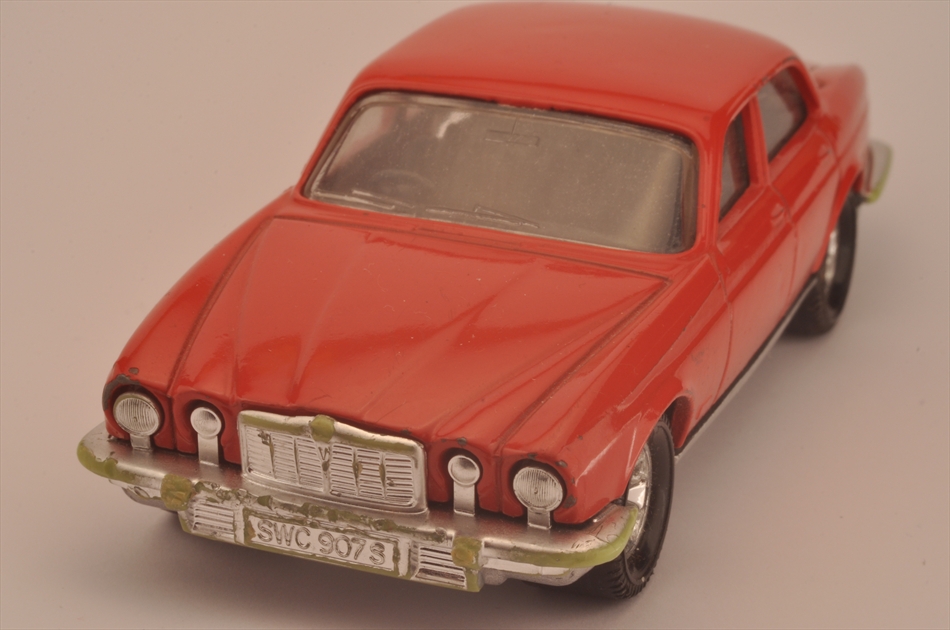
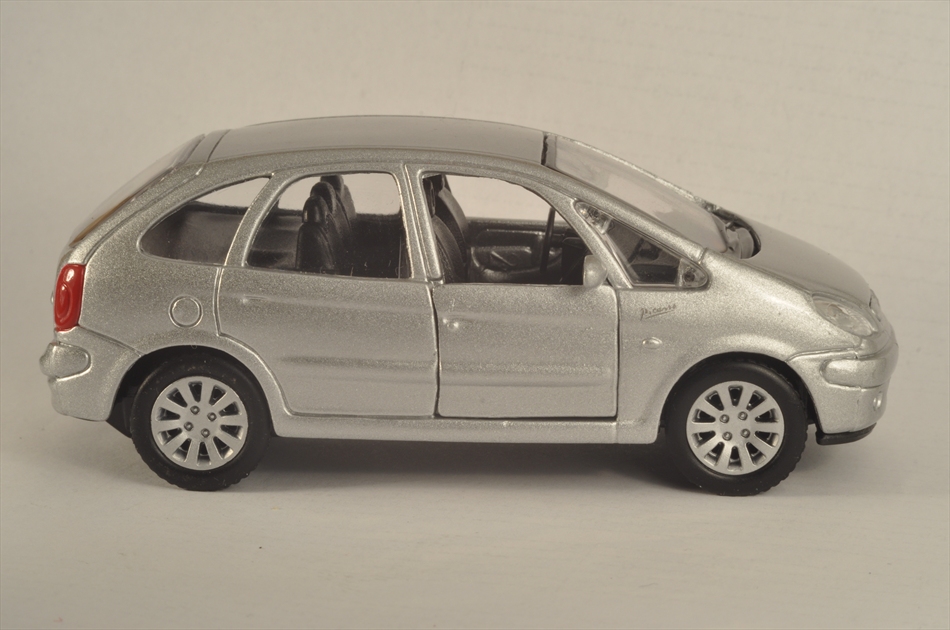
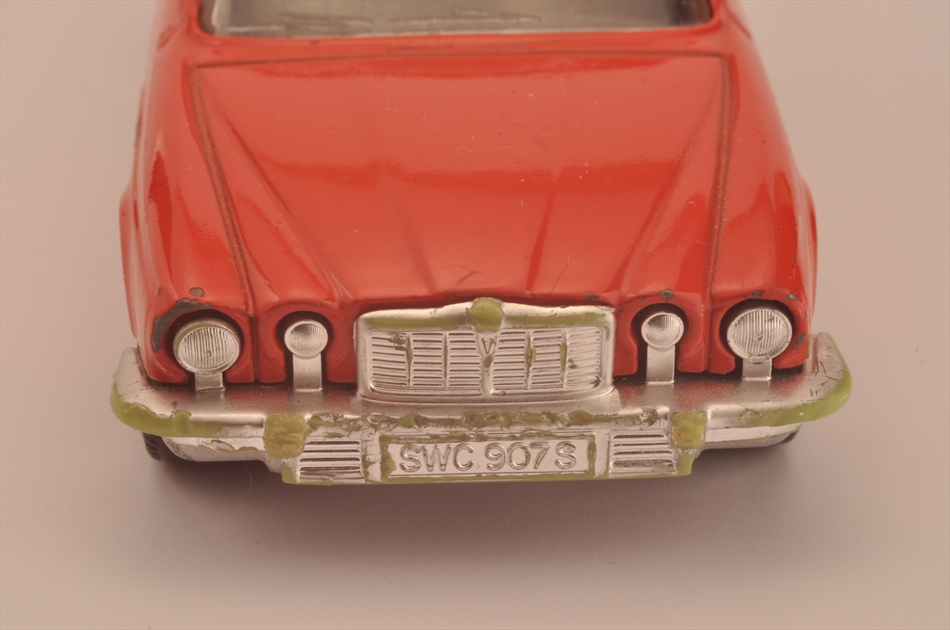

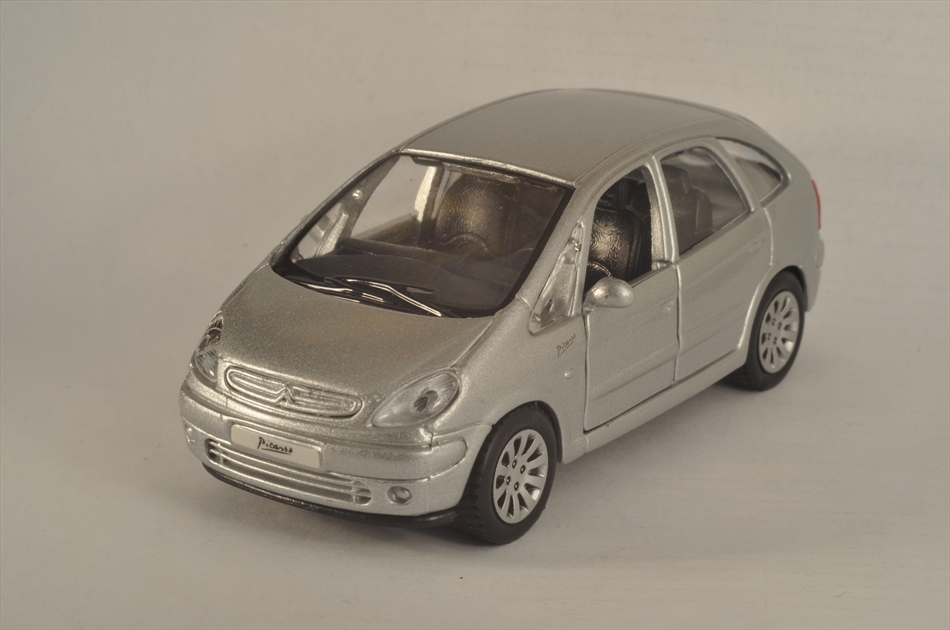
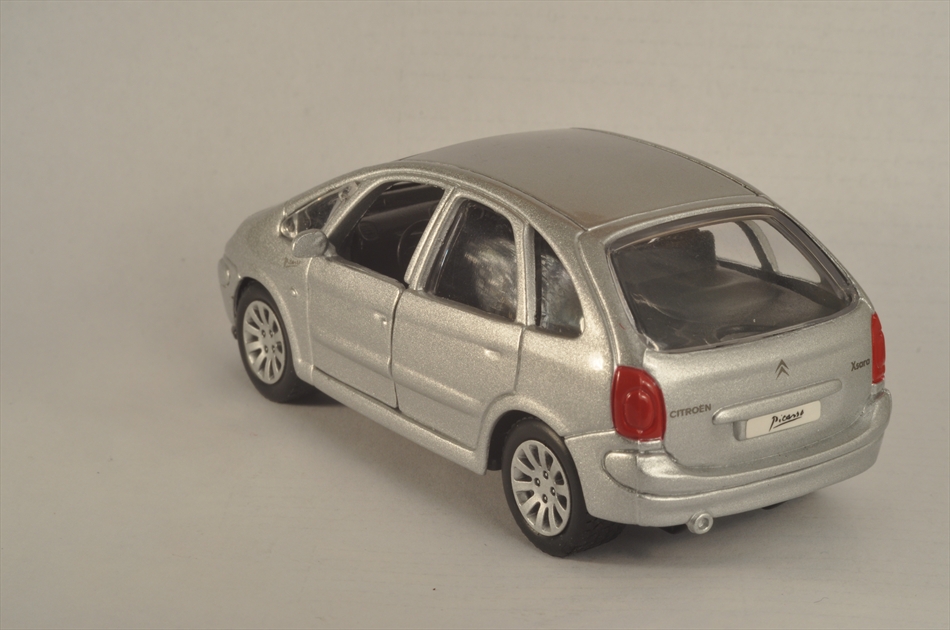
_________________
SLR Cameras:Zenit 122, Praktica MTL5B, Nikon D90, Nikon F90x
RF Cameras: Siluet Elektro
MF Lenses: Helios 44-6 58/2; Pentacon 50/1.8 Electric; Pentacon 135/2.8 Auto; Jupiter 9 85/2; Tamron Adaptall 135/2.8
AF Lenses: Nikon 17-55/2.8 DX; Nikon 70-300 VR; Nikon 50/1.8 D; Nikon 18-70DX; Sigma 24/2.8 |
|
| Back to top |
|
 |
sichko


Joined: 20 Jun 2008
Posts: 2475
Location: South West UK
|
 Posted: Sun Dec 06, 2009 9:47 pm Post subject: Posted: Sun Dec 06, 2009 9:47 pm Post subject: |
 |
|
sichko wrote:
The picturers look very nice. It would be interesting to see comparable picturers taken with and without the optical adapter. Which adapter did you use ?
Also could you put a "return" after the 1st picture so that the 2nd picture is below it ?
_________________
John |
|
| Back to top |
|
 |
seuret

Joined: 29 Nov 2009
Posts: 34
Location: Bulgaria
|
 Posted: Sun Dec 06, 2009 11:50 pm Post subject: Posted: Sun Dec 06, 2009 11:50 pm Post subject: |
 |
|
seuret wrote:
| sichko wrote: |
The picturers look very nice. It would be interesting to see comparable picturers taken with and without the optical adapter. Which adapter did you use ?
Also could you put a "return" after the 1st picture so that the 2nd picture is below it ? |
Hello,
I used the "optical" adapter and now i want to get a non optical to check the same that you are interested in.
The second photo is not below the first  . It's taken with all of the extension rings mounted so it the whole photo. It's from a very close distance so i couldn't shoot the whole car model. . It's taken with all of the extension rings mounted so it the whole photo. It's from a very close distance so i couldn't shoot the whole car model.
_________________
SLR Cameras:Zenit 122, Praktica MTL5B, Nikon D90, Nikon F90x
RF Cameras: Siluet Elektro
MF Lenses: Helios 44-6 58/2; Pentacon 50/1.8 Electric; Pentacon 135/2.8 Auto; Jupiter 9 85/2; Tamron Adaptall 135/2.8
AF Lenses: Nikon 17-55/2.8 DX; Nikon 70-300 VR; Nikon 50/1.8 D; Nikon 18-70DX; Sigma 24/2.8 |
|
| Back to top |
|
 |
|
|
